Impact of κ-Carrageenan on the Freshwater Mussel (Solenaia oleivora) Protein Emulsion Gels: Gel Formation, Stability, and Curcumin Delivery
Abstract
1. Introduction
2. Results and Discussion
2.1. Emulsion Characterization
2.1.1. Particle Size Distribution and ζ-Potential
2.1.2. Encapsulation Efficiency of Curcumin in Emulsions
2.2. Emulsion Gel Formation and Characterization
2.2.1. Visual Appearance
2.2.2. Water Holding Capacity
2.2.3. Textural Properties
2.3. Chemical Stability of Curcumin in the Emulsion and Emulsion Gel
2.4. In Vitro Digestion
2.4.1. Free Fatty Acids Release
2.4.2. In Vitro Digestive Stability
2.4.3. Bioaccessibility of Curcumin
3. Conclusions
4. Materials and Methods
4.1. Materials
4.2. Freshwater Mussel (Solenaia oleivora) Protein Isolation and Ultrasound Treatment
4.3. Emulsion Preparation
4.4. Particle Size Distribution and ζ-Potential Measurement
4.5. Encapsulation Efficiency of Curcumin in the Emulsion
4.6. Emulsion Gel Fabrication
4.7. Water Holding Capacity Analysis
4.8. Texture Profile Analysis
4.9. Stability of Curcumin in Emulsion Gels
4.10. In Vitro Digestion Analysis
4.10.1. Simulated Gastrointestinal Digestion
4.10.2. Free Fatty Acid Measurement
4.10.3. Stability and Bioaccessibility of Curcumin during the Digestion
4.11. Statistical Analysis
Author Contributions
Funding
Institutional Review Board Statement
Informed Consent Statement
Data Availability Statement
Conflicts of Interest
References
- Lu, Y.; Mao, L.K.; Hou, Z.Q.; Miao, S.; Gao, Y.X. Development of emulsion gels for the delivery of functional food ingredients: From structure to functionality. Food Eng. Rev. 2019, 11, 245–258. [Google Scholar] [CrossRef]
- Mao, L.K.; Lu, Y.; Cui, M.N.; Miao, S.; Gao, Y.X. Design of gel structures in water and oil phases for improved delivery of bioactive food ingredients. Crit. Rev. Food Sci. Nutr. 2020, 60, 1651–1666. [Google Scholar] [CrossRef] [PubMed]
- Lin, D.Q.; Kelly, A.L.; Maidannyk, V.; Miao, S. Effect of structuring emulsion gels by whey or soy protein isolate on the structure, mechanical properties, and in-vitro digestion of alginate-based emulsion gel beads. Food Hydrocoll. 2021, 110, 106165. [Google Scholar] [CrossRef]
- Xu, Y.; Sun, L.P.; Zhuang, Y.L.; Gu, Y.; Cheng, G.G.; Fan, X.J.; Ding, Y.Y.; Liu, H.T. Protein-stabilized emulsion gels with improved emulsifying and gelling properties for the delivery of bioactive ingredients: A review. Foods 2023, 12, 2703. [Google Scholar] [CrossRef] [PubMed]
- Zhu, S.C.; Zhu, H.; Xu, S.Y.; Lv, S.B.; Liu, S.L.; Ding, Y.T.; Zhou, X.X. Gel-type emulsified muscle products: Mechanisms, affecting factors, and applications. Compr. Rev. Food. Sci. Food Saf. 2022, 21, 5225–5242. [Google Scholar] [CrossRef] [PubMed]
- Lin, D.Q.; Kelly, A.L.; Miao, S. Preparation, structure-property relationships and applications of different emulsion gels: Bulk emulsion gels, emulsion gel particles, and fluid emulsion gels. Trends Food Sci. Technol. 2020, 102, 123–137. [Google Scholar] [CrossRef]
- Yan, J.X.; Yin, L.J.; Qu, Y.Y.; Yan, W.J.; Zhang, M.H.; Su, J.Q.; Jia, X. Effect of calcium ions concentration on the properties and microstructures of doubly induced sorghum arabinoxylan/soy protein isolate mixed gels. Food Hydrocoll. 2022, 133, 107997. [Google Scholar] [CrossRef]
- Cao, Y.P.; Mezzenga, R. Design principles of food gels. Nat. Food 2020, 1, 106–118. [Google Scholar] [CrossRef]
- Zhi, L.Y.; Liu, Z.; Wu, C.; Ma, X.J.; Hu, H.; Liu, H.Z.; Adhikari, B.; Wang, Q.; Shi, A.M. Advances in preparation and application of food-grade emulsion gels. Food Chem. 2023, 424, 136399. [Google Scholar] [CrossRef]
- Li, X.J.; Chen, X.; Cheng, H. Impact of κ-carrageenan on the cold-set pea protein isolate emulsion-filled gels: Mechanical property, microstructure, and in vitro digestive behavior. Foods 2024, 13, 483. [Google Scholar] [CrossRef]
- Lin, D.Q.; Kelly, A.L.; Miao, S. The role of mixing sequence in structuring O/W emulsions and emulsion gels produced by electrostatic protein-polysaccharide interactions between soy protein isolate-coated droplets and alginate molecules. Food Hydrocoll. 2021, 113, 106537. [Google Scholar] [CrossRef]
- Li, X.Y.; Chen, W.; Hao, J.; Xu, D.X. Construction of different properties single and double cross-linked binary emulsion filled gels based on rice bran oil body emulsion. Colloids Surf. A-Physicochem. Eng. Asp. 2023, 665, 131238. [Google Scholar] [CrossRef]
- Yang, X.; Li, A.Q.; Li, D.; Guo, Y.R.; Sun, L.J. Applications of mixed polysaccharide-protein systems in fabricating multi-structures of binary food gels-A review. Trends Food Sci. Technol. 2021, 109, 197–210. [Google Scholar] [CrossRef]
- Liu, F.G.; Liang, X.P.; Yan, J.; Zhao, S.L.; Li, S.Q.; Liu, X.B.; Ngai, T.; McClements, D.J. Tailoring the properties of double-crosslinked emulsion gels using structural design principles: Physical characteristics, stability, and delivery of lycopene. Biomaterials 2022, 280, 121265. [Google Scholar] [CrossRef] [PubMed]
- Chen, W.; Ma, X.; Jin, W.; Wen, H.; Cheng, H. Mussel meat protein: Extraction, processing, nutrition value, and application in food products. Food Health 2023, 5, 20. [Google Scholar]
- Zheng, X.H.; Zou, B.W.; Zhang, J.W.; Cai, W.Q.; Na, X.K.; Du, M.; Zhu, B.W.; Wu, C. Recent advances of ultrasound-assisted technology on aquatic protein processing: Extraction, modification, and freezing/thawing-induced oxidation. Trends Food Sci. Technol. 2024, 144, 104309. [Google Scholar] [CrossRef]
- Ma, X.; Sun, G.; Wang, L.; Xu, D.; Jin, W.; Lv, G.; Xu, P.; Ding, T.; Wen, H.; Gu, R. Nutrients and mineral elements in Solenaia oleivora from Huaihe river: Seasonal variations. J. Agric. 2021, 11, 90–94. [Google Scholar]
- Chen, W.W.; Jin, W.; Ma, X.Y.; Wen, H.B.; Li, Y.P.; Xu, G.C.; Xu, P.; Cheng, H. A study on the structure-functionality relationship of Solenaia oleivora protein under high-intensity ultrasonication processing. Food Chem. 2024, 460, 140598. [Google Scholar] [CrossRef]
- Chen, W.; Ma, X.; Jin, W.; Wen, H.; Xu, G.; Xu, P.; Cheng, H. Effects of high-pressure homogenization on the structure and functional properties of Solenaia oleivora proteins. Foods 2024, 13, 2958. [Google Scholar] [CrossRef]
- Tsuda, T. Curcumin as a functional food-derived factor: Degradation products, metabolites, bioactivity, and future perspectives. Food Funct. 2018, 9, 705–714. [Google Scholar] [CrossRef]
- Araiza-Calahorra, A.; Akhtar, M.; Sarkar, A. Recent advances in emulsion-based delivery approaches for curcumin: From encapsulation to bioaccessibility. Trends Food Sci. Technol. 2018, 71, 155–169. [Google Scholar] [CrossRef]
- Schneider, C.; Gordon, O.N.; Edwards, R.L.; Luis, P.B. Degradation of curcumin: From mechanism to biological implications. J. Agric. Food Chem. 2015, 63, 7606–7614. [Google Scholar] [CrossRef] [PubMed]
- Su, J.Q.; Wang, L.L.; Dong, W.X.; Wei, J.; Liu, X.; Yan, J.X.; Ren, F.Z.; Yuan, F.; Wang, P.J. Fabrication and characterization of ultra-high-pressure (UHP)-induced whey protein isolate/κ-carrageenan composite emulsion gels for the delivery of curcumin. Front. Nutr. 2022, 9, 839761. [Google Scholar] [CrossRef] [PubMed]
- Zhou, L.; Cai, J.M.; Wang, J.Y.; Ma, C.; Xing, L.J.; Tang, S.Y.; Zhang, W.A. Effects and mechanisms of ultrasound-assisted emulsification treatment on the curcumin delivery and digestive properties of myofibrillar protein-carboxymethyl cellulose complex emulsion gel. Food Res. Int. 2024, 188, 114531. [Google Scholar] [CrossRef] [PubMed]
- Liu, J.; Yang, S.Q.; Liu, J.Y.; Liu, H.Z.; Wang, Z.Y. Preparation of transglutaminase-catalyzed rice bran protein emulsion gels as a curcumin vehicle. Foods 2024, 13, 2072. [Google Scholar] [CrossRef]
- Qiao, X.; Liu, F.D.; Kong, Z.H.; Yang, Z.Y.; Dai, L.; Wang, Y.F.; Sun, Q.J.; McClements, D.J.; Xu, X.F. Pickering emulsion gel stabilized by pea protein nanoparticle induced by heat-assisted pH-shifting for curcumin delivery. J. Food Eng. 2023, 350, 111504. [Google Scholar] [CrossRef]
- Sen, M.; Erboz, E.N. Determination of critical gelation conditions of kappa-carrageenan by viscosimetric and FT-IR analyses. Food Res. Int. 2010, 43, 1361–1364. [Google Scholar] [CrossRef]
- Dong, Y.; Wei, Z.H.; Xue, C.H. Recent advances in carrageenan-based delivery systems for bioactive ingredients: A review. Trends Food Sci. Technol. 2021, 112, 348–361. [Google Scholar] [CrossRef]
- Schefer, L.; Adamcik, J.; Diener, M.; Mezzenga, R. Supramolecular chiral self-assembly and supercoiling behavior of carrageenans at varying salt conditions. Nanoscale 2015, 7, 16182–16188. [Google Scholar] [CrossRef]
- Liu, D.S.; Zhou, P.; Nicolai, T. Effect of kappa carrageenan on acid-induced gelation of whey protein aggregates. Part II: Microstructure. Food Hydrocoll. 2020, 102, 105590. [Google Scholar] [CrossRef]
- Liu, Z.B.; Ha, S.; Guo, C.F.; Xu, D.; Hu, L.B.; Li, H.B.; Hati, S.; Mo, H.Z. 3D printing of curcumin enriched Pickering emulsion gel stablized by pea protein-carrageenan complexes. Food Hydrocoll. 2024, 146, 109170. [Google Scholar] [CrossRef]
- Cakir, E.; Foegeding, E.A. Combining protein micro-phase separation and protein-polysaccharide segregative phase separation to produce gel structures. Food Hydrocoll. 2011, 25, 1538–1546. [Google Scholar] [CrossRef]
- Le, X.T.; Rioux, L.E.; Turgeon, S.L. Formation and functional properties of protein-polysaccharide electrostatic hydrogels in comparison to protein or polysaccharide hydrogels. Adv. Colloid Interface Sci. 2017, 239, 127–135. [Google Scholar] [CrossRef] [PubMed]
- Sarkar, A.; Murray, B.; Holmes, M.; Ettelaie, R.; Abdalla, A.; Yang, X.Y. In vitro digestion of Pickering emulsions stabilized by soft whey protein microgel particles: Influence of thermal treatment. Soft Matter 2016, 12, 3558–3569. [Google Scholar] [CrossRef] [PubMed]
- Perez, A.A.; Carrara, C.R.; Sánchez, C.C.; Patino, J.M.R.; Santiago, L.G. Interactions between milk whey protein and polysaccharide in solution. Food Chem. 2009, 116, 104–113. [Google Scholar] [CrossRef]
- Perrechil, F.A.; Cunha, R.L. Stabilization of multilayered emulsions by sodium caseinate and κ-carrageenan. Food Hydrocoll. 2013, 30, 606–613. [Google Scholar] [CrossRef]
- Liu, L.Y.; Zhao, Q.Z.; Liu, T.X.; Kong, J.; Long, Z.; Zhao, M.M. Sodium caseinate/carboxymethylcellulose interactions at oil-water interface: Relationship to emulsion stability. Food Chem. 2012, 132, 1822–1829. [Google Scholar] [CrossRef]
- McClements, D.J. Comments on viscosity enhancement and depletion flocculation by polysaccharides. Food Hydrocoll. 2000, 14, 173–177. [Google Scholar] [CrossRef]
- Xue, G.; Zhang, K.; Zheng, Y.; Zheng, H.; Zhou, C.; Gao, J.; Qin, X.; Zhang, C. Extraction of three shellfish protein isolates by isoelectric solubilisation/precipitation and their composition and characteristics analysis. Food Ferment. Ind. 2018, 44, 145–151. [Google Scholar]
- Singh, H.; Tamehana, M.; Hemar, Y.; Munro, P.A. Interfacial compositions, microstructure and stability of oil-in-water emulsions formed with mixtures of milk proteins and κ-carrageenan: 2. Whey protein isolate (WPI). Food Hydrocoll. 2003, 17, 549–561. [Google Scholar] [CrossRef]
- Jiang, T.; Charcosset, C. Encapsulation of curcumin within oil-in-water emulsions prepared by premix membrane emulsification: Impact of droplet size and carrier oil type on physicochemical stability and in vitro bioaccessibility. Food Chem. 2022, 375, 131825. [Google Scholar] [CrossRef]
- Jiang, M.Y.; Gan, Y.L.; Li, Y.L.; Qi, Y.Z.; Zhou, Z.; Fang, X.; Jiao, J.J.; Han, X.; Gao, W.J.; Zhao, J.H. Protein-polysaccharide-based delivery systems for enhancing the bioavailability of curcumin: A review. Int. J. Biol. Macromol. 2023, 250, 126153. [Google Scholar] [CrossRef] [PubMed]
- Li, T.; Wang, L. Improved curcumin bioaccessibility in Pickering emulsion fabricated by rice glutelin fibrils. Food Biosci. 2023, 55, 102988. [Google Scholar] [CrossRef]
- Cheng, H.; Chen, W.W.; Jiang, J.; Khan, M.A.; Wusigale; Liang, L. A comprehensive review of protein-based carriers with simple structures for the co-encapsulation of bioactive agents. Compr. Rev. Food. Sci. Food Saf. 2023, 22, 2017–2042. [Google Scholar] [CrossRef]
- McClements, D.J. Crystals and crystallization in oil-in-water emulsions: Implications for emulsion-based delivery systems. Adv. Colloid Interface Sci. 2012, 174, 1–30. [Google Scholar] [CrossRef] [PubMed]
- Choi, M.; Choi, H.W.; Kim, H.; Hahn, J.; Choi, Y.J. Mimicking animal adipose tissue using a hybrid network-based solid-emulsion gel with soy protein isolate, agar, and alginate. Food Hydrocoll. 2023, 145, 109043. [Google Scholar] [CrossRef]
- Lei, Y.Q.; Ouyang, H.; Peng, W.; Yu, X.W.; Jin, L.; Li, S.G. Effect of NaCl on the rheological, structural, and gelling properties of walnut protein isolate-κ-carrageenan composite gels. Gels 2022, 8, 259. [Google Scholar] [CrossRef]
- Li, X.M.; Meng, R.; Xu, B.C.; Zhang, B. Investigation of the fabrication, characterization, protective effect and digestive mechanism of a novel Pickering emulsion gels. Food Hydrocoll. 2021, 117, 106708. [Google Scholar] [CrossRef]
- Pan, Y.; Li, X.M.; Meng, R.; Xu, B.C.; Zhang, B. Investigation of the formation mechanism and curcumin bioaccessibility of emulsion gels based on sugar beet pectin and laccase catalysis. J. Agric. Food Chem. 2021, 69, 2557–2563. [Google Scholar] [CrossRef]
- Zhang, H.; Huang, Z.; Guo, P.P.; Guo, Q.N.; Zhang, H.J.; Jiang, L.W.; Xia, N.; Xiao, B.W. Tuning egg yolk granules/sodium alginate emulsion gel structure to enhance β-carotene stability and in vitro digestion property. Int. J. Biol. Macromol. 2023, 232, 123444. [Google Scholar] [CrossRef] [PubMed]
- Zhang, B.; Meng, R.; Li, X.L.; Liu, W.J.; Cheng, J.S.; Wang, W. Preparation of Pickering emulsion gels based on κ-carrageenan and covalent crosslinking with EDC: Gelation mechanism and bioaccessibility of curcumin. Food Chem. 2021, 357, 129726. [Google Scholar] [CrossRef]
- Kharat, M.; Du, Z.Y.; Zhang, G.D.; McClements, D.J. Physical and chemical stability of curcumin in aqueous solutions and emulsions: Impact of pH, temperature, and molecular environment. J. Agric. Food Chem. 2017, 65, 1525–1532. [Google Scholar] [CrossRef]
- Puligundla, P.; Mok, C.; Ko, S.; Liang, J.; Recharla, N. Nanotechnological approaches to enhance the bioavailability and therapeutic efficacy of green tea polyphenols. J. Funct. Foods 2017, 34, 139–151. [Google Scholar] [CrossRef]
- Pandey, S.; Senthilguru, K.; Uvanesh, K.; Sagiri, S.S.; Behera, B.; Babu, N.; Bhattacharyya, M.K.; Pal, K.; Banerjee, I. Natural gum modified emulsion gel as single carrier for the oral delivery of probiotic-drug combination. Int. J. Biol. Macromol. 2016, 92, 504–514. [Google Scholar] [CrossRef]
- Zhao, K.; Hao, Y.L.; Gan, J.L.; Ye, H.Q.; Shen, X. Development of quinoa protein emulsion gels to deliver curcumin: Influence of oil type. J. Food Eng. 2025, 384, 112260. [Google Scholar] [CrossRef]
- Chang, Y.G.; McClements, D.J. Influence of emulsifier type on the in vitro digestion of fish oil-in-water emulsions in the presence of an anionic marine polysaccharide (fucoidan): Caseinate, whey protein, lecithin, or Tween 80. Food Hydrocoll. 2016, 61, 92–101. [Google Scholar] [CrossRef]
- Guo, Q.; Ye, A.Q.; Lad, M.; Dalgleish, D.; Singh, H. Impact of colloidal structure of gastric digesta on in-vitro intestinal digestion of whey protein emulsion gels. Food Hydrocoll. 2016, 54, 255–265. [Google Scholar] [CrossRef]
- Verrijssen, T.A.J.; Balduyck, L.G.; Christiaens, S.; Van Loey, A.M.; Van Buggenhout, S.; Hendrickx, M.E. The effect of pectin concentration and degree of methyl-esterification on the in vitro bioaccessibility of β-carotene-enriched emulsions. Food Res. Int. 2014, 57, 71–78. [Google Scholar] [CrossRef]
- Sabet, S.; Rashidinejad, A.; Melton, L.D.; McGillivray, D.J. Recent advances to improve curcumin oral bioavailability. Trends Food Sci. Technol. 2021, 110, 253–266. [Google Scholar] [CrossRef]
- Wu, B.; Li, Y.; Li, Y.Y.; Li, H.; Li, L.L.; Xia, Q. Encapsulation of resveratrol-loaded Pickering emulsions in alginate/pectin hydrogel beads: Improved stability and modification of digestive behavior in the gastrointestinal tract. Int. J. Biol. Macromol. 2022, 222, 337–347. [Google Scholar] [CrossRef]
- Jiang, T.; Liao, W.; Charcosset, C. Recent advances in encapsulation of curcumin in nanoemulsions: A review of encapsulation technologies, bioaccessibility and applications. Food Res. Int. 2020, 132, 109035. [Google Scholar] [CrossRef]
- Zou, L.Q.; Liu, W.; Liu, C.M.; Xiao, H.; McClements, D.J. Designing excipient emulsions to increase nutraceutical bioavailability: Emulsifier type influences curcumin stability and bioaccessibility by altering gastrointestinal fate. Food Funct. 2015, 6, 2475–2486. [Google Scholar] [CrossRef]
- Zhang, L.; Chen, D.L.; Wang, X.F.; Xu, L.; Qian, J.Y.; He, X.D. Enzymatically modified quinoa starch based pickering emulsion as carrier for curcumin: Rheological properties, protection effect and in vitro digestion study. Food Biosci. 2022, 49, 101933. [Google Scholar] [CrossRef]
- Brodkorb, A.; Egger, L.; Alminger, M.; Alvito, P.; Assuncao, R.; Ballance, S.; Bohn, T.; Bourlieu-Lacanal, C.; Boutrou, R.; Carrière, F.; et al. INFOGEST static in vitro simulation of gastrointestinal food digestion. Nat. Protoc. 2019, 14, 991–1014. [Google Scholar] [CrossRef] [PubMed]
- Lin, Q.Q.; Liang, R.; Ye, A.Q.; Singh, H.; Zhong, F. Effects of calcium on lipid digestion in nanoemulsions stabilized by modified starch: Implications for bioaccessibility of β-carotene. Food Hydrocoll. 2017, 73, 184–193. [Google Scholar] [CrossRef]
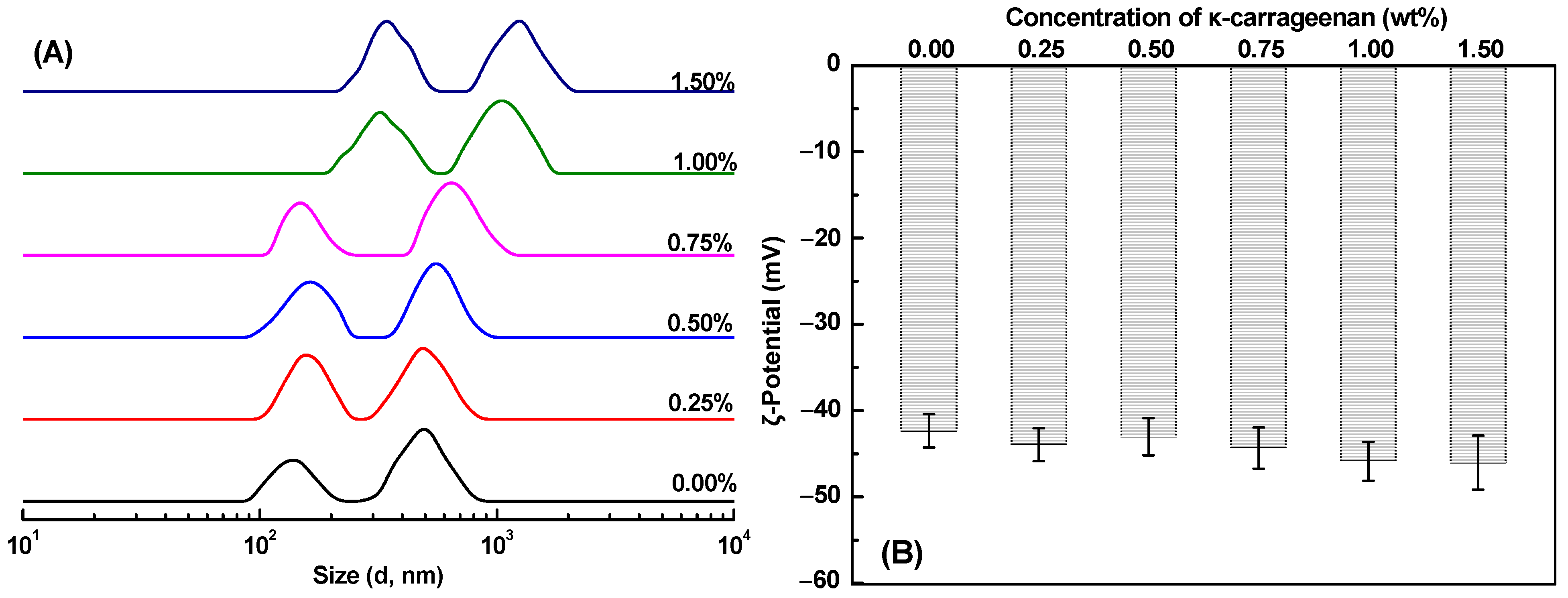
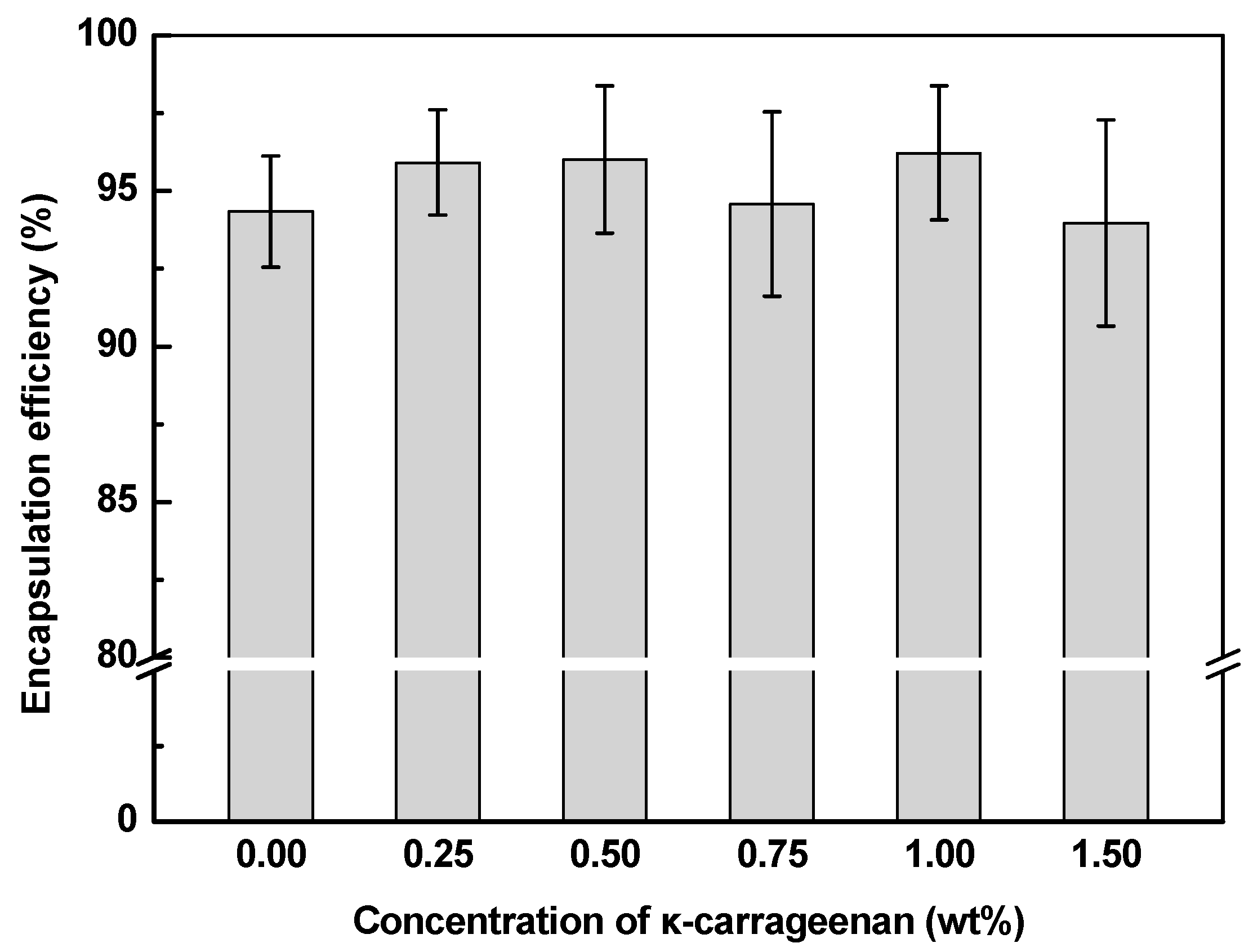
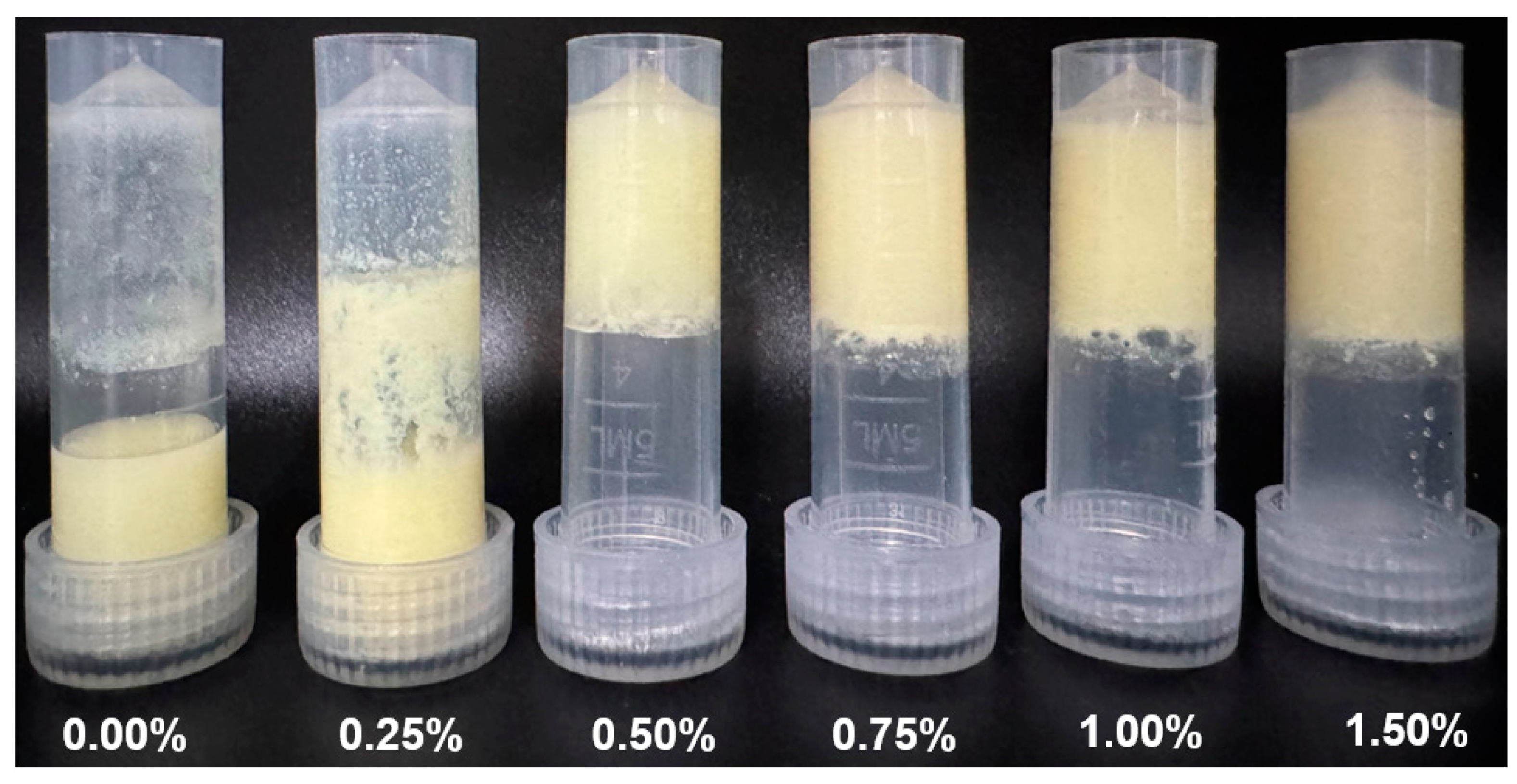
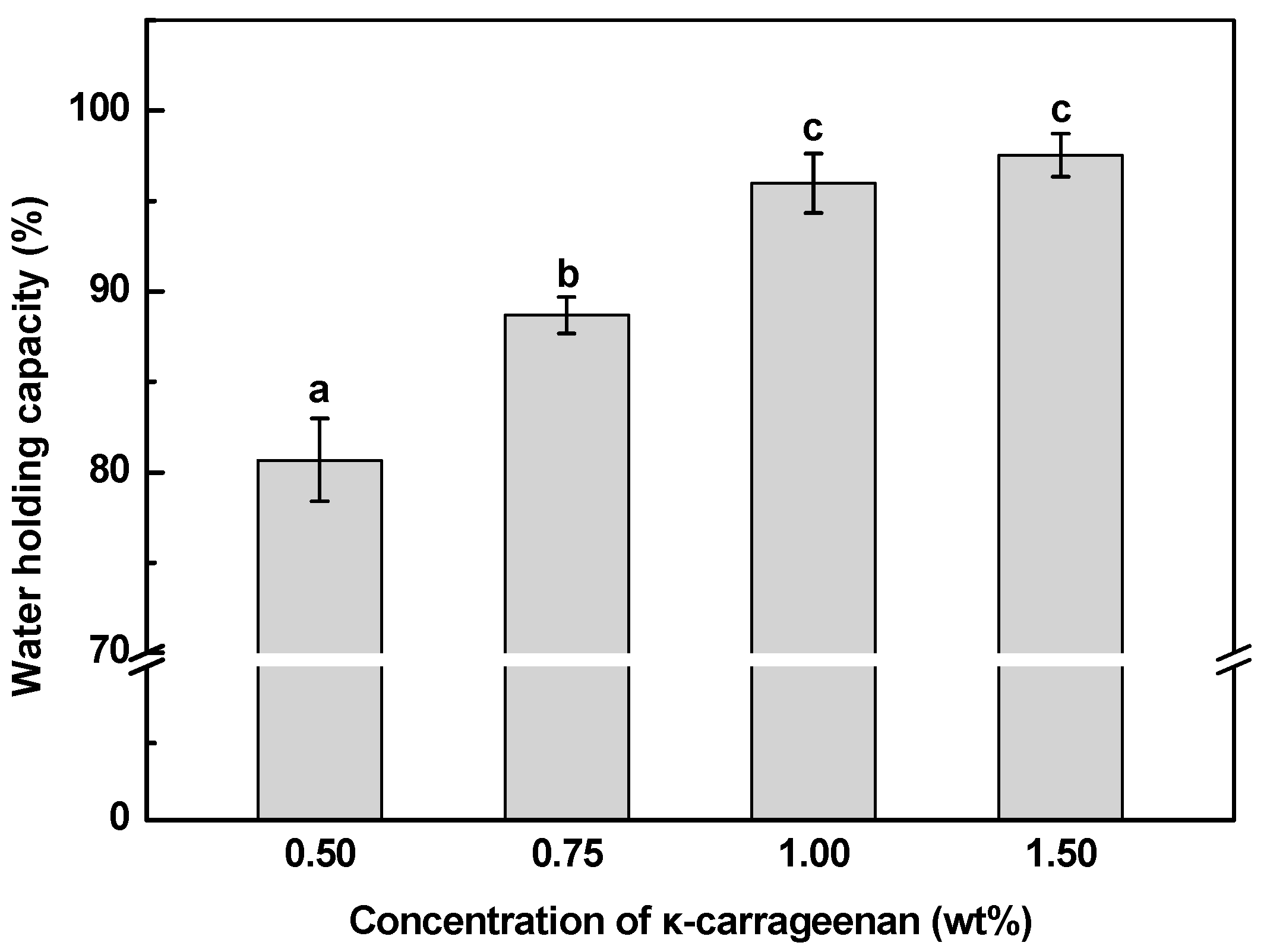
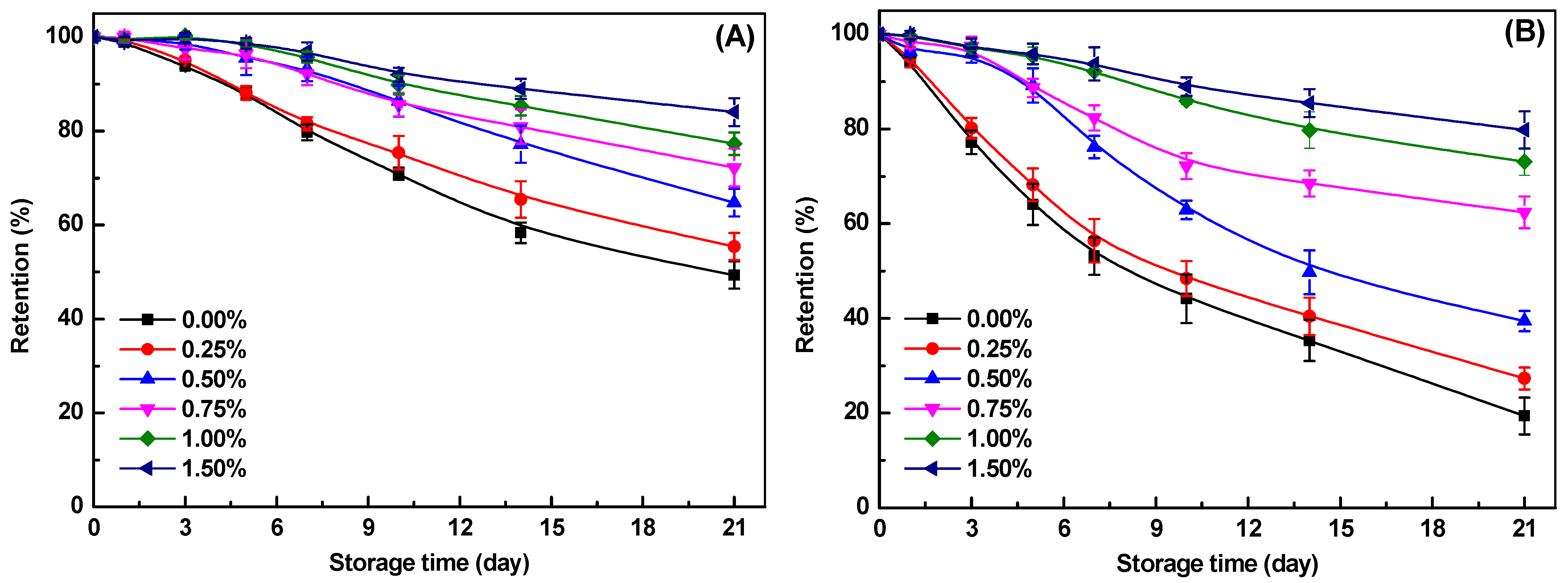

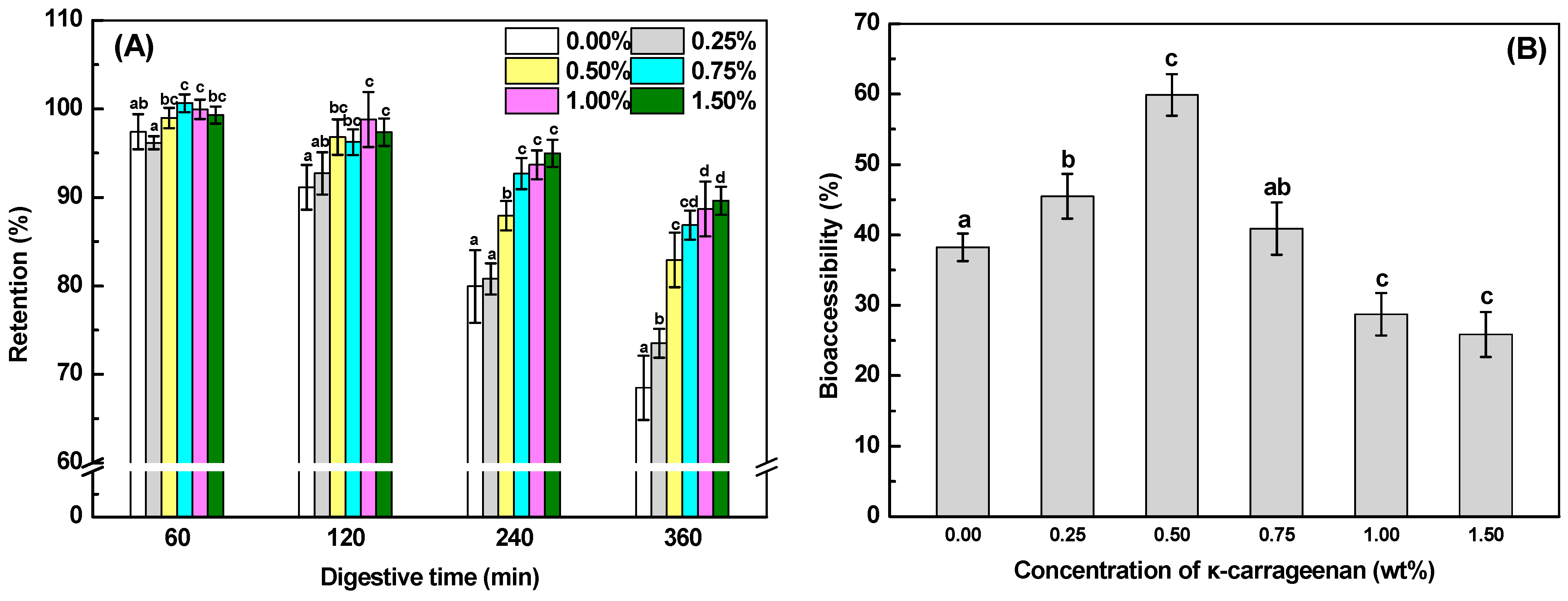
| κ-Carrageenan Concentration (%) | Hardness (g) | Springiness | Cohesiveness | Chewiness (g) |
|---|---|---|---|---|
| 0.50 | 516.8 ± 93.4 a | 0.489 ± 0.021 a | 0.359 ± 0.026 a | 88.91 ± 8.36 a |
| 0.75 | 689.1 ± 53.1 b | 0.510 ± 0.024 ab | 0.361 ± 0.021 a | 139.38 ± 7.56 b |
| 1.00 | 910.7 ± 81.3 c | 0.545 ± 0.023 b | 0.386 ± 0.023 a | 155.18 ± 15.32 bc |
| 1.50 | 1326.3 ± 108.3 d | 0.563 ± 0.039 b | 0.373 ± 0.031 a | 169.32 ± 19.16 c |
Disclaimer/Publisher’s Note: The statements, opinions and data contained in all publications are solely those of the individual author(s) and contributor(s) and not of MDPI and/or the editor(s). MDPI and/or the editor(s) disclaim responsibility for any injury to people or property resulting from any ideas, methods, instructions or products referred to in the content. |
© 2024 by the authors. Licensee MDPI, Basel, Switzerland. This article is an open access article distributed under the terms and conditions of the Creative Commons Attribution (CC BY) license (https://creativecommons.org/licenses/by/4.0/).
Share and Cite
Chen, W.; Jin, W.; Ma, X.; Wen, H.; Xu, G.; Xu, P.; Cheng, H. Impact of κ-Carrageenan on the Freshwater Mussel (Solenaia oleivora) Protein Emulsion Gels: Gel Formation, Stability, and Curcumin Delivery. Gels 2024, 10, 659. https://doi.org/10.3390/gels10100659
Chen W, Jin W, Ma X, Wen H, Xu G, Xu P, Cheng H. Impact of κ-Carrageenan on the Freshwater Mussel (Solenaia oleivora) Protein Emulsion Gels: Gel Formation, Stability, and Curcumin Delivery. Gels. 2024; 10(10):659. https://doi.org/10.3390/gels10100659
Chicago/Turabian StyleChen, Wanwen, Wu Jin, Xueyan Ma, Haibo Wen, Gangchun Xu, Pao Xu, and Hao Cheng. 2024. "Impact of κ-Carrageenan on the Freshwater Mussel (Solenaia oleivora) Protein Emulsion Gels: Gel Formation, Stability, and Curcumin Delivery" Gels 10, no. 10: 659. https://doi.org/10.3390/gels10100659
APA StyleChen, W., Jin, W., Ma, X., Wen, H., Xu, G., Xu, P., & Cheng, H. (2024). Impact of κ-Carrageenan on the Freshwater Mussel (Solenaia oleivora) Protein Emulsion Gels: Gel Formation, Stability, and Curcumin Delivery. Gels, 10(10), 659. https://doi.org/10.3390/gels10100659








